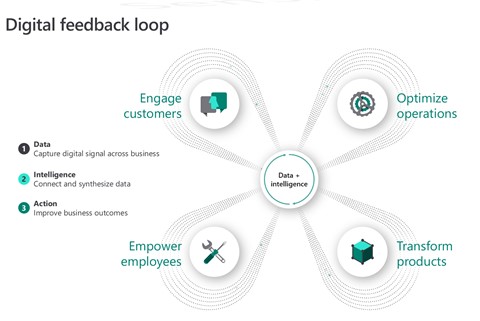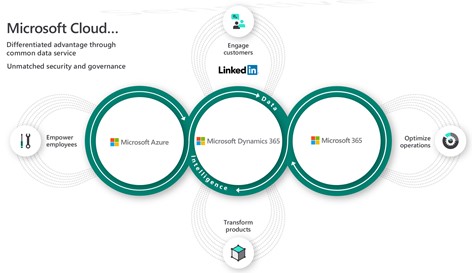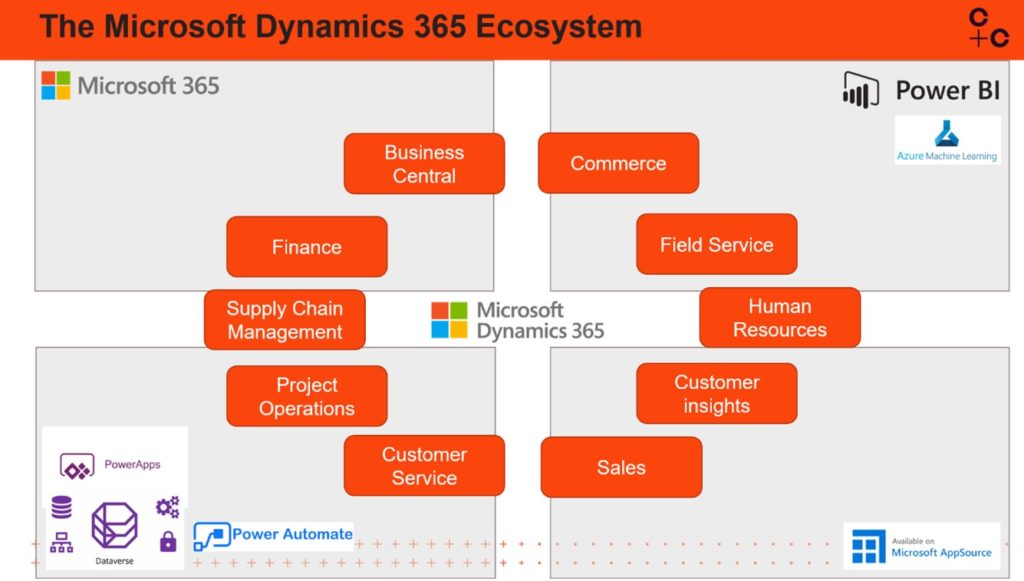
Duncan Kerr, Enterprise Applications Solution Specialist at Content+Cloud, examines what you need to consider when using Microsoft Dynamics 365 to smooth digital transformation.
Microsoft often uses the following graphic to describe a businesses’ digital transformation journey.

Microsoft’s positioning is that there are four direct areas which require focus throughout a business’s digital transformation. The express purpose of this is to acknowledge the growth of data, which is converted into intelligence that offers managers and decision-makers the tools they need to improve business outcomes.
This four-pronged approach is an ideal framework, not too dissimilar to the Kaplan and Norton Balanced Scorecard approach, to review how a business can tackle its journey.
I am going to use the above model to review how Microsoft Dynamics 365 can address the common challenges businesses face during their digital transformation.
Defining the basics: What is Microsoft Dynamics 365?
First of all, for context, it is important to understand what Dynamics 365 is. In its basic sense, it represents one of Microsoft’s Three Clouds, along with Azure and Microsoft 365.

Dynamics 365 represents Microsoft’s business applications cloud. Nowadays, most technology providers package their products into applications. In this respect, Microsoft is no different and in the case of Dynamics 365, it has split this into multiple apps.
It should also be seen in the context of the wider Microsoft app ecosystem – Power Apps, Power Automate, Power BI, AppSource and Microsoft 365. All of which can be used to address challenges and drive real business outcomes.

Each of the blocks in this diagram represents an app within Microsoft Dynamics 365. So, when you hear that a company is using Dynamics 365, it’s interesting to consider which of these apps it is most benefitting from. However, it is this platform which we can use to address the digital transformation journey.
Listen, respond and engage with customers
This will be different in each industry and each company, but across the board, the way businesses manage their customers is ever-changing to keep up with evolving expectations.
Whether driven by client expectations (e.g., “I can track my parcel from x vendor, so why can’t I track it with y vendor?”) or new, more agile and more customer-focused entrants to the market, business that do not transform will wither.
It’s commonly acknowledged that retention is much more cost-effective than acquisition. Therefore, nurturing, listening and responding to feedback are key. Customers expect a tailored experience from whoever they speak to and want to have their issues resolved efficiently.
They must be able to place orders in the way they want, when they want, with the most competitive pricing and service in the market. They are happy to receive marketing, but it must be of value and relevant to them.
Customer Insights built alongside Dynamics 365 Sales and Customer Service helps your employees understand who they are talking to and how best to help them.
Power Apps Portals allow you to build tailored online engagement while controlling content (knowledgebase) and security-based access for users to place orders, access documents and engage online.
Power Virtual Assistants ensure you can offer a 24-hour service, even when the teams aren’t online. But before implementing any technology, answer the question “how do your customers want to engage with you?” and use this as a basis for the decisions you make.
Automate and optimise your way to success
As touched upon, many industries have seen disruptors enter the market. Think Uber, Airbnb and Just Eat. These are companies with no infrastructure, no legacy and operations, designed from scratch for the digital age. They have become synonymous with all things cutting-edge and enjoy ongoing success.
If your business was starting now from scratch, how would you structure your operations? Where are the challenges in your supply chain? It’s important that your operations are as automated as possible and that your teams handle only exceptions and ad-hoc requests, rather than run-of-the-mill, day-to-day operations.
Eliminating bottlenecks, manual processes and delays in reporting is key to optimising your operational processes. Customer expectations will require accurate operations. Think back to the days when flatpack furniture had the wrong parts, or toys had bits missing – such oversights are no longer acceptable to customers.
Applications such as Business Central or Dynamics 365 Supply Chain Management help ensure operations flow. But extending them with the Power Platform can ensure everyone is involved in optimisation.
Using Power Automate to notify exceptions can help you deal with challenges and Power BI reporting can ensure you have real-time data at your fingertips.
Use technology to transform your products
Are your competitors bringing new products to market? Does this process look like it’s easy for them? It’s important that your service and product offerings are relevant and match customer desires. But underpinning this is innovation – are you moving with the times and offering the right things suitable for a digital world?
Back-office solutions such as Business Central or Supply Chain help you build and bring products to market. But why not build out the Power Platform to help you manage innovation and R&D for product design?
Gather ideas via SharePoint from multiple sources – customers, suppliers, employees – and turn them into products using the tacit knowledge within your organisation. Turn it into a challenge through gamification, rewarding the best ideas. But underpin this, using the Microsoft ecosystem, with technology to speed up time-to-market.
Empower your employees
This is, without a doubt, the area of digital transformation I’m most passionate about. We spend many years of our lives at school, college and university, gathering knowledge.
After so much effort building our skillsets, it would be a great shame – not to mention inefficient – if we dedicated most of our days to tasks that could be automated, while taking our attention from innovation.
Each employee has untapped value which can help drive digital transformation. Some are more comfortable than others with technology, but digital transformation is not about technology alone.
It is about automating processes and tapping human intelligence and creativity to solve the ever-evolving challenges of running a business. This could be anything from new product innovation to leading improvements in communicating with clients, vendors, colleagues or the public.
Investing in both Microsoft Dynamics 365 and business change and adoption services from your technology partner can be key to improving employee experience and ensuring your people get the most from their working lives. In turn, this can enable you to focus on getting the most out of your team and contribute to driving your digital transformation.

